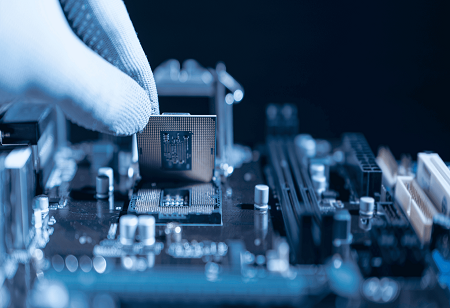There is a plan by the Indian government to invest 2 billion dollars in the
semiconductor laboratory in Mohali, which would focus on
research and prototyping. This is however a rise from the previous investment of $1.3 billion that was agreed upon. The union minister Rajeev Chandrasekhar announced it during a semiconductor design roadshow in IIT-Delhi. The minister further disclosed that the Indian government was planning to start the India Semiconductor Research Institute as the centre of excellence. The spoke-hub model shall be followed and institutes like IIT Delhi shall be worked with.
The actions like these are a sign for where the semiconductor industry in India is headed. In an attempt to become a global semiconductor manufacturing base, these initiatives will become the central factor. Let us consider how such operations will affect the semiconductor manufacturing scenario in India.
Attracting global semiconductor manufacturers
Upgrading India's semiconductor labs will show to the global semiconductor manufacturers that India is serious about becoming an assembly hub for semiconductor manufacturing. This will drive investment into the country, as firms will be more comfortable setting up factories in India, knowing that they will also access top-class facilities, qualified labor force, and a supportive business environment.
Another instance that illustrates how the fab has the ability to attract international semiconductor companies is the relationship between TSMC and Taiwan Semiconductor Manufacturing Company (TSMC). In 1980s Taiwanese government created an institute to apply their research and development in the semiconductor industry. Tsai Ing-wen's administration, therefore, initiated a policy change in 1987, and TSMC was established as a joint venture between government and private sectors.
TSMC has made an investment into the development of the semiconductor laboratory equipped with the latest, innovative equipment and cutting-edge technology. By doing this, the company has gained an advantage of low cost and high quality of semiconductor manufacturing service instead of the competitor. TSMC started off as a place of innovation and growth, which caught the attention of many potential international semiconductor partners.
Equipment installation in the semiconductor labs will necessitate the creation of a very talented workforce in the country. It will entail the training of engineers, technicians, and also other professionals on the newest semiconductor technologies and procedures. India can lure more semiconductor companies by providing them a skilled workforce which is well trained to do the daily operations of these companies.
One example of how developing a skilled workforce drew the international semiconductor companies is showing the case of Singapore. In the late 1980s, the Singapore government started a plan to turn the country into a high-tech hub and to attract global semiconductor companies to establish their operations in the country. To fulfill the goal the government of Singapore has invested a lot amount of money in the education and workforce development programs to build a highly skilled workforce in the electronics and semiconductor industry. The government also established specialized training centers, e.g., the Institute of Microelectronics, which are to train and do research for the students and professionals.
Such efforts transformed the Singaporean workforce into highly skilled, technically savvy and knowledgeable in the areas of semiconductor manufacturing and design. This meant the country became a very good place for multinational semiconductor firms seeking high-skilled workers. Companies like Intel, Texas Instruments, and Micron Technology were some of the very first to establish their businesses in Singapore, drawn by the highly skilled workforce, tax advantages, and excellent infrastructure in the country.
Developing indigenous semiconductor technology
India needs to have many semiconductor laboratories to encourage the national self-reliance in the semiconductor technology. This gives India the ability to become less dependent on the importing of the semiconductor parts and also equipment and to build a self-reliant manufacturing system. India will become a hub of the semiconductor manufacturing in the world, thus, it will be able to advance its own semiconductor technology as well as take the position of the leader in innovation and advanced manufacturing.
In India, the Semiconductor Complex Limited (SCL) has led to the many indigenous semiconductor technology. In the late 1970s, India was importing most of the semiconductors (chips) required by its growing electronic industry. Hence, it was felt that the indigenous technology would help to reduce this dependency and make India a self sufficient in the field of electronics. Hence, the SCL was conceived in Mohali, in collaboration with the Soviet Union. The laboratory first concentrated on the discrete production of the components like diodes and transistors. But, soon it broadened its scope and thus, it started producing integrated circuits as well.
The emergence of SCL resulted in the creation of many such indigenous semiconductor technologies. Likewise, SCL invented a modified P-N junction technique, which was specially designed for the Indian conditions such as temperature and humidity. This technology was used to fabricate diodes and other devices that were unconditionally designed to work in harsh conditions of the Indian climate.
Going forward, semiconductor laboratories investment will be the main factor that molds the semiconductor industry future in India. In the wake of escalating need for electronic devices, the nation should be invested in setting up the semiconductor technologies. In order for Indian manufacturers to be able to compete with global leaders, their semiconductor labs should have access to the most advanced tools, equipment and research facilities. The more the investment in these labs, the Indian semiconductor manufacturing ecosystem will be developed, this will further improve the economy of the country, create jobs and reduce the country’s dependence on imports.
